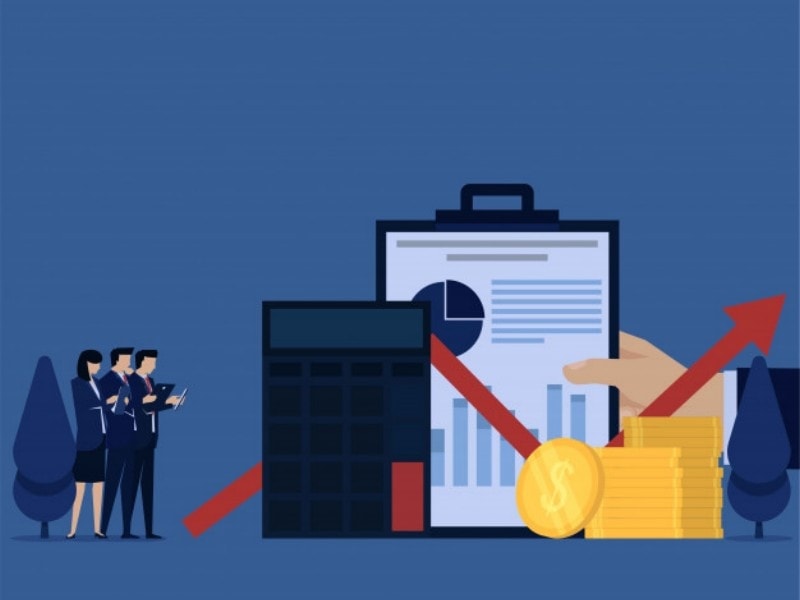The final earnings or profit, earnings per share EPS, or Net Income is referred to as the bottom line of the company. The bottom name line is given because of its location and the statement of the company’s income statement. The net profit is located at the bottom of the company’s income statement.
Any actions that may change – increase or decrease – the net profit of the company, that is where the bottom line is commonly used as a reference to those actions. The bottom line is said to be improving when a company is reducing it’s expenditure or increasing its earnings.
Bottom line is what is seen to determine the financial stability of the company. Bottom line is also evaluated carefully when there are corporate mergers.
When the bottom line is strong, then more companies will be interested in merging, but when the bottom line is weak, then there will be attempts for a takeover or acquisition.
Table of Contents
What is Bottom Line?
The net income that is reported at the last line of the income statement is referred to as the bottom line. Usually, the income statement has a regular format, and although there are many versions and their outs of this income statement, all of them show the net profit at the end of the financial statement.
Usually, the income statement starts with the primary business activity for sales and service revenue at the top of the statement.
Other revenue sources, such as income from investments or the interest that is obtained from multiple investments, are listed after that. The expenses that follow after that may be dependent on the nature of the industry or the company.
Sometimes it also depends on the nature of the product as well. Finally, after reducing all of the expenditures, the amount left at the bottom is termed as net profit.
Expansion of the company, hiring new employees, using better raw materials, are the components which reduce the bottom line.
Cost-cutting, using substitute raw materials, an increase in sales, reduction in government taxes are the factors which increase the bottom line.
The ultimate aim of any company should ideally be to increase its bottom line rather focusing on the topline. This will also ensure that the focus of the company is on the right track, and the focus is on the ultimate profit.
This also shows that the company is mindful of their expenses. A strong bottom line is a sign of a financially strong organization.
Bottomline Calculation and Formula
To calculate the bottom line that is net profit, the gross earnings are used, and all the expenditures and costs are subtracted from the mat, including the overheads and the final amount obtained is called net profit.
Net profit = Sales revenue / Gross income from all sources – Total costs, expenditures.
Net profit is the measurability of the fundamental profit of the organization. When all of the expenses are reduced, government latest form the sales revenue is termed as net profit.
It is a common misunderstanding that if the target exceeds the profit also increases. This can be proved with the help of the following example:
Total target = $ 10K
Salaries and Overhead costs = $ 4K
Procurement costs = $ 3K
Other expenses = $ 2K
Total expenses = $ 9K
Taxes = $ 1K
Target achievement at the end of the year = $ 10.1K
Net profit = total achievement – total expenses including taxes
Net profit = 10.1 K – 10K = 0.1 K
Therefore the net profit is $ 0.1K.
In the above example, although it may seem that the target is achieved, the profit that is left after taxes and removing expenses is very less. Therefore the bottom line will give a true picture of the financial stability of an organization and not the top line, which includes only Gross sales and income.
Increasing the bottom line
Management may use many strategies in order to increase the bottom line because it is the Net profit which is utilized by the corporations to show growth.
This profit is also to be shown in the book of records for the investors and shareholders to provide them effective Return on Investment. Primarily there are two strategies that can be used to increase the bottom line:
- Increasing revenue
- Reducing costs
1) Increasing revenue
In order to apply this strategy, the management may motivate the sales team to achieve higher numbers and provide them special incentives and bonuses when they achieve the required number.
In some organizations, profits are shared with the Sales team not after the achievement of targets but after exceeding the targets. This is the most common method used by many organizations which is why the target allocation is done precisely targeting a larger growth.
Another strategy for increasing the revenue is by expanding the business to a new area. Many companies expand globally in order to generate more revenue from different locations. With the help of digital marketing, the companies have to invest very little in order to promote their products, and the profits earned are incremental.
On the other hand, if the companies use traditional modes of marketing, then they would require to incur a huge cost, and the output may not be so predictable or fruitful.
Most of the companies follow the strategy of increasing revenue during the expansion phase or the growth phase of their products. It is also followed when the company’s relatively new entrant in the market and there are no other competitors present to compete with.
It would be a very difficult strategy for an already established company with a saturated market to follow and implement.
2) Reducing costs:
When the market is already established, and there are many competitors in the market, or when there is an economic slowdown, then the company uses this strategy to maintain their bottom line.
The company aims at reducing the cost, which will either maintain or increase their profitability, thereby affecting its bottom line positively.
Many companies avoid the expenditures over the employees like the bonus which are given out every year may get reduced or the increments which employees receive at the end of every year may not be given for a particular duration in order to maintain the profitability.
The other strategy to reduce costs would be using cheaper raw materials which were over there production costs which will automatically lower the expenses.
Apart from decreasing wages and benefits of the employees for using cheaper raw materials, some companies may use the strategy of operating out of relatively inexpensive facilities which will reduce the cost of capital.
Apart from these two methods, there are few more methods which help in increasing the bottom line. They are as follows:
3) Pricing adjustments
Pricing the product is one of the important decisions of the company and can make or break the product. This also has a direct impact on the bottom line profitability of the company. Whenever the company expects a change in the bottom line, Pricing is the first factor that is changed.
Not every time reducing the price increases the bottom line but sometimes increasing the price also increases the bottom line.
4) Effective Marketing campaigns:
Investing in marketing is one of the wisest decision that the company can make. Traditional marketing methods cost a lot to the company.
And the returns that are expected at least ten times the investment in the marketing. This is why a combination of traditional marketing and digital marketing can be used in order to reach the right customer and target the proper customers.
The cost of digital marketing is very less as compared to traditional marketing, and the effectiveness rate is much higher as compared to the latter because of specific targeting by Digital marketing.
If the marketing campaign is effective than the company can rest assured that the business will pick up, which will ultimately increase the bottom line.
5) Sales Collection
Focusing on the collections can also increase the bottom line immediately. There are many customers who pay late because of money for different reasons. Because of these late payers, the cash flow can be seriously affected.
The company can revise the payment schedule and effectively follow up with the customers to collect the payment after a transaction has been done.
Alternatively, the company can also reward the customers who pay early with certain schemes or bonuses or reward points which will motivate the customers further to pay early.
If the connections are made within the time, then this can drastically push the bottom line upwards and make the balance sheet greener and more profitable.
Triple Bottom Line Concept
The concept of the triple bottom line was introduced by John Elkington in the year 1994. According to this concept, two more bottom lines are added to to the regular bottom line of profitability, which are social and environmental.
For example if a corporation is showing terms of monetary profit but on the other hand is creating position because of letting the sewage in drinking water and polluting the river then the government spends taxpayers money on cleaning the river and healthcare of the people then it doesn’t make sense to show the financial profitability at the bottom line.
The two additional bottom lines to create better business value. In recent days, many companies have adopted the concept of Triple Bottom line and promoted sustainability.
Here is a video by Marketing91 on Triple Bottom Line.



